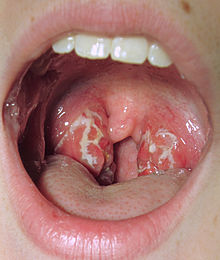User:Mr. Ibrahem/Streptococcal pharyngitis
Template:Good article is only for Wikipedia:Good articles.
| Streptococcal pharyngitis | |
|---|---|
| Other names | Streptococcal tonsillitis, streptococcal sore throat, strep |
 | |
| A culture positive case of streptococcal pharyngitis with typical tonsillar exudate in a 16-year-old. | |
| Specialty | Infectious disease |
| Symptoms | Fever, sore throat, large lymph nodes[1] |
| Usual onset | 1–3 days after exposure[2][3] |
| Duration | 7–10 days[2][3] |
| Causes | Group A streptococcus[1] |
| Risk factors | Sharing drinks or eating utensils[4] |
| Diagnostic method | Throat culture, strep test[1] |
| Differential diagnosis | Epiglottitis, infectious mononucleosis, Ludwig's angina, peritonsillar abscess, retropharyngeal abscess, viral pharyngitis[5] |
| Prevention | Handwashing,[1] covering coughs[4] |
| Treatment | Paracetamol (acetaminophen), NSAIDs, antibiotics[1][6] |
| Frequency | 5 to 40% of sore throats[7][8] |
Streptococcal pharyngitis, also known as strep throat, is an infection of the back of the throat including the tonsils caused by group A streptococcus (GAS).[1] Common symptoms include fever, sore throat, red tonsils, and enlarged lymph nodes in the neck.[1] A headache, and nausea or vomiting may also occur.[1] Some develop a sandpaper-like rash which is known as scarlet fever.[2] Symptoms typically begin one to three days after exposure and last seven to ten days.[2][3]
Strep throat is spread by respiratory droplets from an infected person.[1] It may be spread directly or by touching something that has droplets on it and then touching the mouth, nose, or eyes.[1] Some people may carry the bacteria without symptoms.[1] It may also be spread by skin infected with group A strep.[1] Diagnosis is based on a rapid strep test or throat culture in those who have symptoms.[9][10]
Prevention is by washing hands and not sharing eating utensils.[1] There is no vaccine for the disease.[1] Treatment with antibiotics is only recommended in those with a confirmed diagnosis.[9] Those infected should stay away from other people for at least 24 hours after starting treatment.[1] Pain can be treated with paracetamol (acetaminophen) and nonsteroidal anti-inflammatory drugs (NSAIDS) such as ibuprofen.[6]
Strep throat is a common bacterial infection in children with an estimated 288 million cases occuring in children age five to 14 years a year.[11] It is the cause of 15–40% of sore throats among children[7][12] and 5–15% among adults.[8] Cases are more common in late winter and early spring.[12] Potential complications include rheumatic fever and peritonsillar abscess.[1]
References[edit]
- ^ a b c d e f g h i j k l m n o p "Is your sore throat strep?". Centers for Disease Control and Prevention. 2 November 2022. Archived from the original on 3 December 2022. Retrieved 5 December 2022.
- ^ a b c d Török, edited by David A. Warrell, Timothy M. Cox, John D. Firth; with guest ed. Estée (2012). Oxford textbook of medicine infection. Oxford: Oxford University Press. pp. 280–281. ISBN 9780191631733. Archived from the original on 2016-10-10.
{{cite book}}:|first1=has generic name (help)CS1 maint: multiple names: authors list (link) - ^ a b c Jr, [edited by] Allan H. Goroll, Albert G. Mulley (2009). Primary care medicine : office evaluation and management of the adult patient (6th ed.). Philadelphia: Wolters Kluwer Health/Lippincott Williams & Wilkins. p. 1408. ISBN 9780781775137. Archived from the original on 2016-09-15.
{{cite book}}:|first1=has generic name (help)CS1 maint: multiple names: authors list (link) - ^ a b "Strep throat - Symptoms and causes". Mayo Clinic. Archived from the original on 4 July 2021. Retrieved 24 January 2020.
- ^ Gottlieb, M; Long, B; Koyfman, A (May 2018). "Clinical Mimics: An Emergency Medicine-Focused Review of Streptococcal Pharyngitis Mimics". The Journal of Emergency Medicine. 54 (5): 619–629. doi:10.1016/j.jemermed.2018.01.031. PMID 29523424.
- ^ a b Weber, R (March 2014). "Pharyngitis". Primary Care. 41 (1): 91–8. doi:10.1016/j.pop.2013.10.010. PMC 7119355. PMID 24439883.
- ^ a b Shaikh N, Leonard E, Martin JM (September 2010). "Prevalence of streptococcal pharyngitis and streptococcal carriage in children: a meta-analysis". Pediatrics. 126 (3): e557–64. doi:10.1542/peds.2009-2648. PMID 20696723.
- ^ a b Shulman, ST; Bisno, AL; Clegg, HW; Gerber, MA; Kaplan, EL; Lee, G; Martin, JM; Van Beneden, C (Sep 9, 2012). "Clinical Practice Guideline for the Diagnosis and Management of Group A Streptococcal Pharyngitis: 2012 Update by the Infectious Diseases Society of America". Clinical Infectious Diseases. 55 (10): e86–102. doi:10.1093/cid/cis629. PMID 22965026.
- ^ a b Harris, AM; Hicks, LA; Qaseem, A (19 January 2016). "Appropriate Antibiotic Use for Acute Respiratory Tract Infection in Adults: Advice for High-Value Care From the American College of Physicians and the Centers for Disease Control and Prevention". Annals of Internal Medicine. 164 (6): 425–34. doi:10.7326/M15-1840. PMID 26785402.
- ^ Ton, Joey (28 October 2019). "#246 Just wait a minute: Point-of-care testing for Group A Streptococcal pharyngitis". CFPCLearn. Archived from the original on 25 March 2023. Retrieved 15 June 2023.
- ^ Miller, Kate M.; Carapetis, Jonathan R.; Beneden, Chris A. Van; Cadarette, Daniel; Daw, Jessica N.; Moore, Hannah C.; Bloom, David E.; Cannon, Jeffrey W. (1 June 2022). "The global burden of sore throat and group A Streptococcus pharyngitis: A systematic review and meta-analysis". eClinicalMedicine. 48. doi:10.1016/j.eclinm.2022.101458. ISSN 2589-5370. Archived from the original on 3 December 2022. Retrieved 5 December 2022.
- ^ a b Choby BA (March 2009). "Diagnosis and treatment of streptococcal pharyngitis". Am Fam Physician. 79 (5): 383–90. PMID 19275067. Archived from the original on 2015-02-08.
